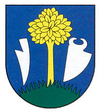Hradište (Partizánske)
| Hradište | ||
|---|---|---|
| coat of arms | map | |

|
|
|
| Basic data | ||
| State : | Slovakia | |
| Kraj : | Trenčiansky kraj | |
| Okres : | Partizánske | |
| Region : | Horná Nitra | |
| Area : | 8.166 km² | |
| Residents : | 1,008 (Dec. 31, 2019) | |
| Population density : | 123 inhabitants per km² | |
| Height : | 215 m nm | |
| Postal code : | 958 54 | |
| Telephone code : | 0 38 | |
| Geographic location : | 48 ° 41 ' N , 18 ° 23' E | |
| License plate : | PE | |
| Kód obce : | 542962 | |
| structure | ||
| Community type : | local community | |
| Administration (as of November 2018) | ||
| Mayor : | Miloš Baránik | |
| Address: | Obecný úrad Hradište Hradište 278 958 54 Hradište |
|
| Website: | www.obec-hradiste.sk | |
| Statistics information on statistics.sk | ||
Hradište (Hungarian Sziklavárhegy - until 1907 Szkacsányhradistye - older only Hradistye ) is a municipality and a town in the west of Slovakia , with a population of 1,008 (as of December 31, 2019). It lies in the Okres Partizánske , a district of the higher administrative unit Trenčiansky kraj .
geography
Hradište is located in the northeastern tip of the Slovakian Danube Hills , more precisely the lower part of the Nitrianska pahorkatina ( Neutra Hills ) on the Nitrica River , a left tributary of Nitra , nine kilometers north of Partizánske and 20 kilometers west of Prievidza .
history
The origin of the place is still unclear, but it is assumed that it was built sometime in the 9th century. A Romanesque church was built around 1096. Hradište (literally: castle site) is mentioned in writing for the first time in 1232 as Haranenicha and belonged to a Christian order that spread Christianity in what was then the Kingdom of Hungary, and from 1424 to the Diocese of Neutra . Another mention comes from the year 1553, where 12 porta are given in a tax register of the place Hradyscha . The same document also claims the existence of a castle-like complex in 1406. After 1777 the place belonged to the Neutra chapter. In 1828 Hradište had 48 houses and 336 residents. The main sources of income for the population were agriculture, fruit growing and weaving.
After the collapse of Austria-Hungary in 1918 and the Treaty of Trianon, the place became part of Czechoslovakia.
Attractions
- Romanesque Barnabas church from the end of the 11th century
